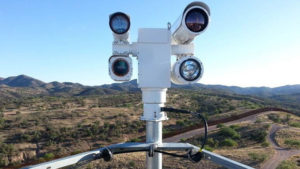
In the high desert east of this border town, the rolling hills topped with mesquite and paloverde trees are a picture of rugged desolation. But there are flashes of movement: Darting between bushes are five migrants who just crossed into Arizona.
Not one U.S. Border Patrol agent is within sight, but the group is about to be spotted anyway, and their entry thwarted. What blocked their path was a surveillance tower brimming with high-technology cameras and radar systems. When the camera focused on the group, a binoculars-wielding smuggler lookout in Mexico noticed and by cellphone directed the migrants to return to Mexico.
Installed mostly on hilltops in rural areas, the 80- to 180-foot towers — each outfitted with radar and a pair of night and day cameras — can scan hundreds of square miles of rugged terrain. However, the technology-driven approach is a low priority since President Trump has focused his strategy on a “giant” wall. The administration’s budget request for 2019 included $1.6 billion for wall funding, compared with $200 million for technology improvements.
Critics and agents alike have questioned the imbalance. At a Senate hearing last April, David Aguilar, the former acting commissioner of Customs and Border Protection, said technology is the “highest” need of the Border Patrol. “It gives you situational awareness, it gives you intelligence … and it gives you the capability to respond in an effective and in a safe manner.”
The idea of a “virtual” border first evolved during the administration of President George W. Bush, but the program was plagued by performance snags and cost overruns. However, the improvements have been groundbreaking to the point that it has sparked concerns about privacy.
The cameras are so powerful they can zoom into windows and cars in Mexico and the U.S. Beth Lusby, a 78-year-old who described herself as pro-Border Patrol, said the tower, along with highway checkpoints, are preferable enforcement options over an “ugly” wall. “We don’t have problems with the tower,” she said. “We have to give up a little of our freedom to maintain it.”

Recent Comments